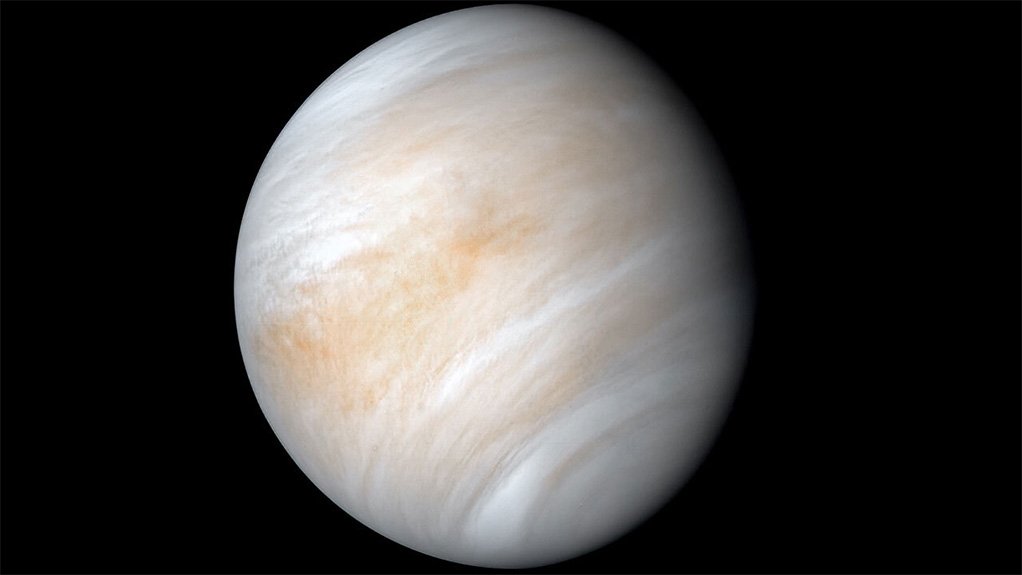Signs of life on Venus?


A 1974 visible wavelength image of Venus, taken by the Mariner 10 spacecraft and recently reprocessed with modern technology to make the structure of its clouds more visible.
Photo by Nasa
An international (UK-US-Japan) team of astronomers has stunned the scientific world by announcing the discovery of a rare molecule in the atmosphere of Venus, the third planet from the Sun, and Earth’s nearest neighbour (often called Earth’s ‘non-identical twin’, because the two are so similar in size, mass and gravity). That molecule is phosphine, which is composed of hydrogen and phosphorous.
On Earth, there are only two sources of phosphine. One is industrial production, which is obviously not taking place on Venus. The other source is microbial life which thrives in oxygen-free environments. “When we got the first hints of phosphine in Venus’s spectrum, it was a shock!” affirmed University of Cardiff astronomer and research team leader Professor Jane Greaves.
The phosphine was first detected in observations from the James Clerk Maxwell Telescope of the East Asian Observatory in the US state of Hawaii. This discovery was then confirmed by observations from the Atacama Large Millimetre/submillimetre Array (better known as ALMA) observatory in Chile.
On its surface, Venus is ferociously hot, with a mean temperature of 467 ˚C. But high in the planet’s cloud-filled atmosphere, the temperature is only 30 ˚C. On the other hand, that atmosphere is full of acid.
The phosphine in the Venusian atmosphere was found in a low concentration of some 20 molecules in every billion molecules. But this was still ten thousand times greater than any concentration of phosphine that could be created by any known natural non-biological means. On Earth, bacteria absorb phosphates from minerals or biological matter, absorb hydrogen, and finally release phosphine. To produce the levels of phosphine detected on Venus, Earth bacteria would need to work at only 10% of their maximum productivity.
“The discovery raises many questions, such as how any organisms could survive,” pointed out Massachusetts Institute of Technology molecular astrophysicist and research team member Dr Clara Sousa-Silva. “On Earth, some microbes can cope with up to 5% of acid in their environment – but the clouds of Venus are almost entirely made of acid.” Venus’s high clouds are about 90%-composed of sulphuric acid.
The discovery does not prove that there is life on Venus. But it does suggest that there could be life on Venus.
“The non-biological production of phosphine on Venus is excluded by our current understanding of phosphine chemistry in rocky planets’ atmospheres,” highlighted European Southern Observatory astronomer and ALMA European operations manager Leonardo Testi, who was not a member of the research team. “Confirming the existence of life on [sic] Venus’s atmosphere would be a major breakthrough for astrobiology; thus, it is essential to follow-up on this exciting result with theoretical and observational studies to exclude the possibility that phosphine on rocky planets may also have a chemical origin different than on Earth.”
Comments
Press Office
Announcements
What's On
Subscribe to improve your user experience...
Option 1 (equivalent of R125 a month):
Receive a weekly copy of Creamer Media's Engineering News & Mining Weekly magazine
(print copy for those in South Africa and e-magazine for those outside of South Africa)
Receive daily email newsletters
Access to full search results
Access archive of magazine back copies
Access to Projects in Progress
Access to ONE Research Report of your choice in PDF format
Option 2 (equivalent of R375 a month):
All benefits from Option 1
PLUS
Access to Creamer Media's Research Channel Africa for ALL Research Reports, in PDF format, on various industrial and mining sectors
including Electricity; Water; Energy Transition; Hydrogen; Roads, Rail and Ports; Coal; Gold; Platinum; Battery Metals; etc.
Already a subscriber?
Forgotten your password?
Receive weekly copy of Creamer Media's Engineering News & Mining Weekly magazine (print copy for those in South Africa and e-magazine for those outside of South Africa)
➕
Recieve daily email newsletters
➕
Access to full search results
➕
Access archive of magazine back copies
➕
Access to Projects in Progress
➕
Access to ONE Research Report of your choice in PDF format
RESEARCH CHANNEL AFRICA
R4500 (equivalent of R375 a month)
SUBSCRIBEAll benefits from Option 1
➕
Access to Creamer Media's Research Channel Africa for ALL Research Reports on various industrial and mining sectors, in PDF format, including on:
Electricity
➕
Water
➕
Energy Transition
➕
Hydrogen
➕
Roads, Rail and Ports
➕
Coal
➕
Gold
➕
Platinum
➕
Battery Metals
➕
etc.
Receive all benefits from Option 1 or Option 2 delivered to numerous people at your company
➕
Multiple User names and Passwords for simultaneous log-ins
➕
Intranet integration access to all in your organisation



















